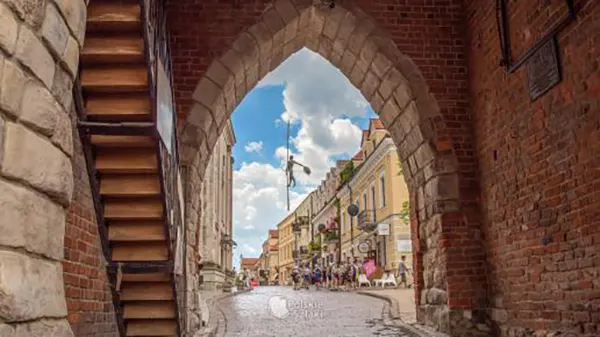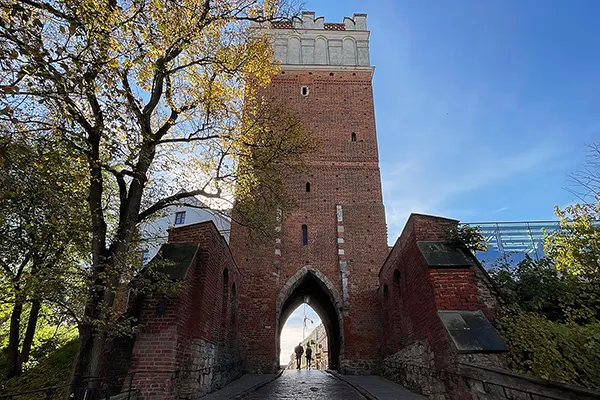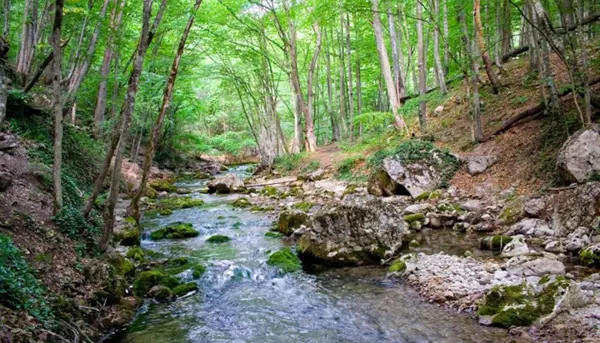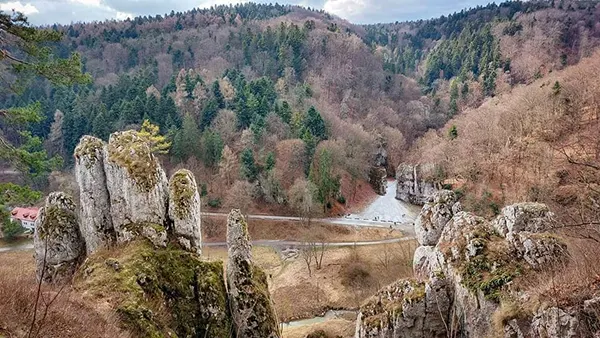
Brama Opatowska in Sandomierz: A Gothic Landmark of Polish Heritage
Brama Opatowska, or the Opatów Gate, is one of the most recognisable symbols of Sandomierz. Built in the 14th century, this Gothic city gate is the last surviving entry point from the original medieval fortifications. Today, it stands as both a historical monument and a viewing platform, drawing visitors who want to experience the city’s layered past and panoramic views. Its preservation and function as a cultural site make it a vital piece of Poland’s architectural heritage.
Architecture and Construction of Brama Opatowska
The Opatów Gate represents the characteristic Gothic defensive style of the late Middle Ages. Constructed from brick, its tall rectangular tower was designed to impress as well as protect, standing approximately 32 metres high. The façade features pointed archways, narrow windows, and decorative battlements, which highlight the craftsmanship of medieval builders.
Originally, the gate was part of a much larger defence system surrounding Sandomierz, which included walls, towers, and additional gates. Over the centuries, many of these structures were dismantled, leaving the Opatów Gate as the best-preserved fragment of the city’s fortifications. Restorations in the 19th and 20th centuries helped stabilise the tower while preserving its authentic Gothic character.
Visitors today can notice details that reveal its defensive function. Arrow slits, thick walls, and the upper gallery served as protection points for guards. The architectural design was both practical and symbolic, representing Sandomierz’s wealth and strategic importance during Poland’s medieval era.
The Role of the Gate in Medieval Sandomierz
During the Middle Ages, Sandomierz was an important trade centre located on the route between Kraków and Lublin. The Opatów Gate served not only as a point of defence but also as a customs checkpoint, where merchants entering the city had to pay fees for goods. This made the gate a vital part of the local economy.
In times of conflict, the gate was heavily fortified to repel invasions. Its height allowed guards to monitor the surrounding landscape and prepare against potential attacks. Chronicles mention that the gate was used strategically during conflicts with invading forces, making it a key defensive structure in the region.
Beyond its military role, the gate also held ceremonial significance. Important visitors, including royal envoys and foreign merchants, would enter Sandomierz through the Opatów Gate, symbolising the city’s prestige and openness to trade and culture.
Visiting the Opatów Gate Today
In the 21st century, Brama Opatowska serves as a cultural and tourist attraction. Managed by local heritage authorities, it offers a unique opportunity to step back in time while also enjoying modern amenities for visitors. Information boards and guided tours provide historical context, ensuring that the significance of the monument is not lost on today’s audience.
The gate’s observation deck is its main highlight. After climbing a narrow staircase, visitors are rewarded with a panoramic view of Sandomierz’s old town, the Vistula River, and the rolling hills beyond. This view has made the Opatów Gate one of the most photographed locations in the city.
Accessibility improvements over recent decades have made the site easier to visit, with safety measures in place for tourists. Seasonal events, such as medieval fairs, often feature activities around the gate, reinforcing its role as a living part of the city’s cultural landscape.
How to Reach Brama Opatowska
The Opatów Gate is centrally located in Sandomierz, within walking distance of the city’s historic market square. For visitors travelling from Warsaw, Kraków, or Lublin, Sandomierz is accessible by car, regional buses, and rail connections. The journey from Kraków takes around three hours by car, making it a manageable day trip.
Once in Sandomierz, the gate is easily reachable on foot through the cobblestone streets of the old town. Its position near cafés, museums, and other landmarks allows visitors to combine a tour of the gate with a broader exploration of Sandomierz’s cultural heritage.
Parking and tourist facilities are available nearby, and local guides often include the Opatów Gate as the starting point of city tours. Its central location ensures it remains both a symbolic and practical entry point into the historic heart of Sandomierz.

Legends, Comparisons and Historical Significance
Like many medieval monuments, the Opatów Gate is surrounded by legends. Stories speak of secret passages beneath the structure and tales of defenders who bravely fought against invaders. These narratives enrich the monument’s historical importance, blending fact with folklore in ways that fascinate both residents and tourists.
When compared with other surviving city gates in Poland, such as those in Kraków or Toruń, the Opatów Gate stands out due to its remarkable state of preservation. While others have undergone extensive reconstruction, Sandomierz’s gate retains much of its original Gothic structure, making it a valuable reference for historians.
Today, the Opatów Gate continues to symbolise resilience. Despite wars, demolitions, and centuries of change, it remains a proud marker of Sandomierz’s identity and cultural continuity. Its enduring presence highlights the city’s role as a guardian of Poland’s architectural and historical traditions.
Comparisons with Other Polish City Gates
Across Poland, many medieval city gates were dismantled as towns modernised, yet several examples remain. The Florian Gate in Kraków and the Monastery Gate in Gdańsk serve similar roles as symbols of heritage. However, the Opatów Gate is unique in offering direct access to a viewing platform, giving visitors both historical context and scenic reward.
Architecturally, it shares the Gothic style common to Poland’s late medieval fortifications, but each gate reflects regional differences. The Opatów Gate’s brick construction aligns it with Mazovian and Lesser Poland traditions, while northern examples often combine stone and brick elements.
For cultural tourism, the Opatów Gate has become a defining landmark of Sandomierz, setting the city apart from other historical centres. Its combination of authenticity, accessibility, and cultural significance ensures it remains one of the most meaningful city gates preserved in Poland.
Popular articles
-
 Roztocze — the Green Pearl of Eastern Poland
Roztocze — the Green Pearl of Eastern PolandRoztocze, a scenic region stretching across the Lublin Voivodeship in …
-
 Kraków Valleys — Picturesque Gorges, Rocks and Walking Trails near Kraków
Kraków Valleys — Picturesque Gorges, Rocks and Walking Trails near KrakówThe Kraków Valleys, known in Polish as Dolinki Krakowskie, are …
-
 Brama Opatowska in Sandomierz: A Gothic Landmark of Polish Heritage
Brama Opatowska in Sandomierz: A Gothic Landmark of Polish HeritageBrama Opatowska, or the Opatów Gate, is one of the …
